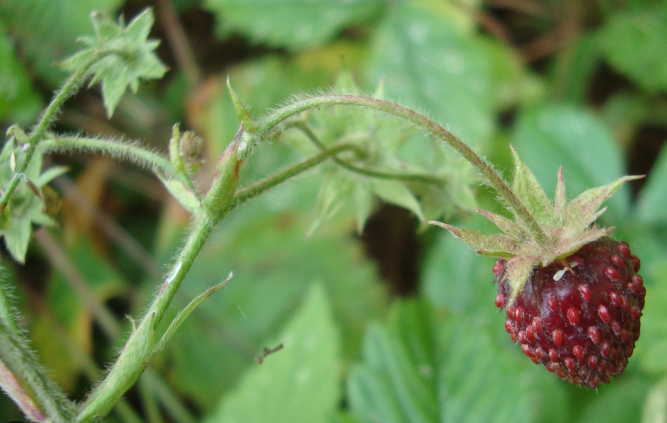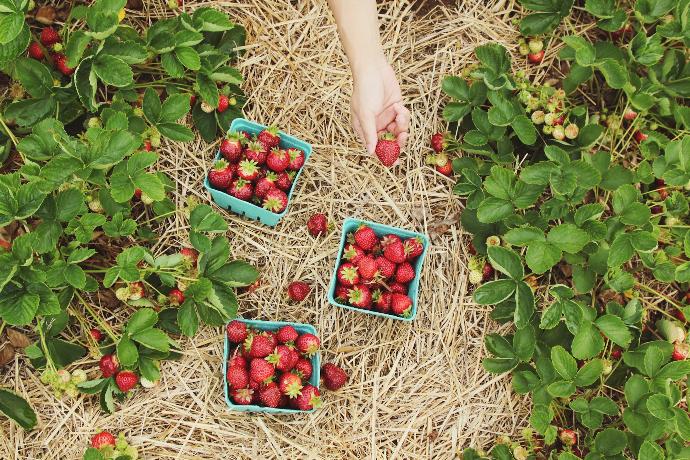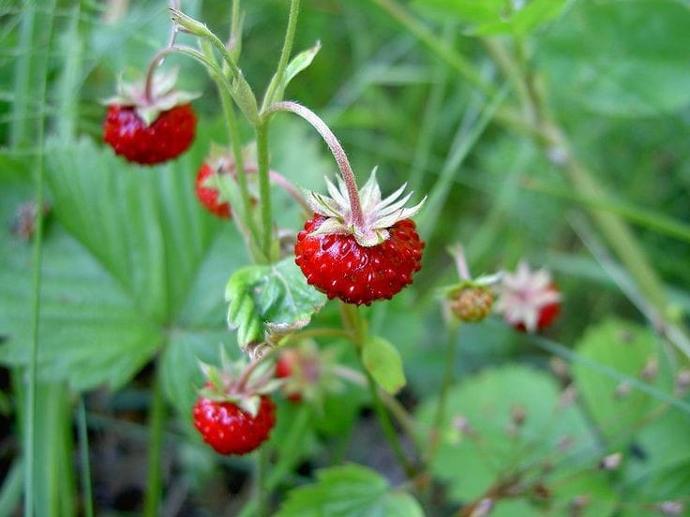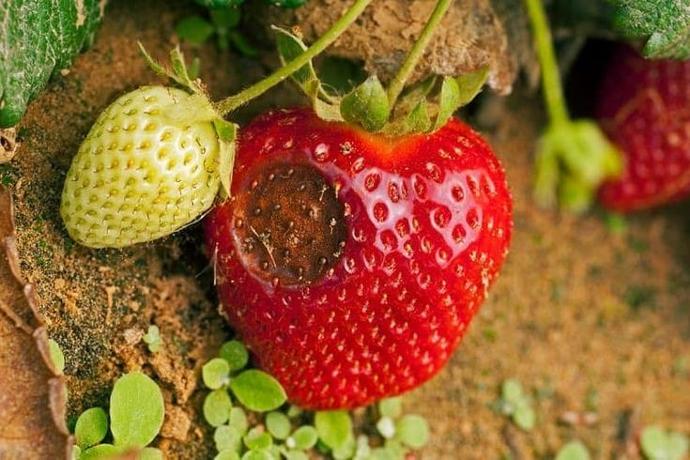Musk Strawberry
Musk strawberries, 6-12 inches in height and suited for Zones 4-9, prefer well-drained soil under full sun. Known for their small and fragrant berries, musk strawberries are a delightful ground cover.

Habit
Perennial
Height
0.2-0.3 m
Growth
Moderate
Soil
Well-drained, loamy
Shade
Full Sun
Moisture
Moderate
Edible
Yes
Medicinal
Yes
Origin
Europe, North America
Climatic Condition
Temperate
Temperature (°)
15-25°C
Humidity (%)
60-75%
Potting media
Loamy, peat
Fertilizers
Balanced NPK (10-10-10)
Watering
Regular, moderate
Plant Weight
200-300 g
Flowering Time
Spring, Summer
Soil Ph level
5.5 - 6.5
Water Ph level
6.0 to 7.0
Soil EC
1-2 dS/m
Yield Per Plant
Edible fruits
NPK ratio
10:20:20
life Span
Perennial
Health Benefits
Rich in vitamin C, antioxidants
Suggested Grow Media or Potting Mix ?
50% compost, 30% perlite, 20% peat moss
Suggested Fertigation/Fertilizers
Fertilize every 2 weeks with a balanced, water-soluble fertilizer.
Common Diseases and Remedies
- Powdery mildew , Alternaria spot , Black root rot , Anthracnose (black spot)
Infected leaves curl upward, become purplish on the underside and, in severe instances, develop badly burned areas at the margin. A white, powdery fungus growth may be seen on the underside of severely affected leaves.
Regularly remove and destroy infected plant parts to reduce the pathogen's presence and potential spread. Avoid wetting the foliage to minimize moisture on leaves as it favours spore germination and infection.
HEALTH BENEFITS
l Rich in vitamin C and antioxidants, supporting immunity.
l Promotes skin health and reduces aging signs.
l Helps regulate blood sugar and cholesterol levels.
l Good for digestion due to high fiber content.
What Is An Musk Strawberry?
Musk strawberries are a variety of strawberries known for their unique aroma, which has a musky scent. They are a type of Fragaria × ananassa, the common garden strawberry, but with a distinct fragrance. Musk strawberry, also known as Fragaria moschata, is a species of strawberry plant. It produces small, sweet berries with a distinctive musky aroma, hence the name. These strawberries are less common than the widely cultivated garden strawberries but are appreciated for their unique flavor.

What Are The Different Types Of Strawberry Plants?
There are various types of musk strawberries, also known as Alpine strawberries. Some popular varieties include Alexandria, Mignonette, and Ruegen. Each type may differ in flavor, size, and growing conditions.
Alpine
Alexandria strawberries are an alpine type strawberry known for their abundant harvests and sweet, flavorful berries. Under ideal, they will continue to blossom and produce fruit from late fall into autumn of the second year. Their relatively small size also makes them a good choice for indoor or container growing. Alexandrias do not put out runners.

How To Care For Musk Strawberry?
1. Location
Musk strawberries, also known as musk fragaria or wild strawberries, thrive in various locations but prefer slightly acidic soil with good drainage. They can be grown in gardens, containers, or even hanging baskets. They typically do well in temperate climates with plenty of sunlight.
2. Sunshine
Musk strawberry needs full sun every day, and these plants rely on a minimum of six hours of sunlight to keep their leaves, roots, and blooms in a healthy state. Even though most perennials need six hours of sunlight a day, plants like the Orange Daylily or Giant Coreopsis could live off less sun for a minimum of three hours daily. Even though these perennial flowering plants can live with only three hours of direct sunlight, they won't be able to thrive like they would in sunnier conditions.
3. Soil
Musk strawberries, also known as wild strawberries, prefer well-drained soil with plenty of organic matter. A mixture of sandy loam and compost is ideal for growing them, as it provides good drainage and nutrients. Make sure the soil pH is slightly acidic, around 5.5 to 6.5, for optimal growth.
4. Hydration
Hydration is crucial for musk strawberries, as they require consistent moisture to thrive. Water them deeply and regularly, ensuring the soil remains consistently moist but not waterlogged. Mulching around the plants can help retain moisture in the soil and prevent evaporation. Aim to water early in the day to minimize moisture loss due to evaporation, and avoid wetting the foliage to prevent diseases. Adjust watering frequency based on weather conditions, such as hot or dry spells, to maintain optimal moisture levels for your musk strawberries.

5. Nourishment
Musk strawberries, also known as "musk melons" or "pineberry," require similar care to other varieties of strawberries. They thrive in well-draining soil rich in organic matter and prefer full sun. Regular watering is essential, especially during dry periods. Consider using a balanced fertilizer formulated for strawberries to provide necessary nutrients. Additionally, mulching around the plants can help retain moisture and suppress weeds. Regular pruning of runners and old leaves can also promote healthier growth and fruit production.
6. Issues
Underwatering and overwatering can both occur as problems for your Musk strawberry, and both these problems can manifest with similar symptoms. For example, foliage discoloration and wilting can both result from either overwatering or underwatering.
What Are The Benifits Of Musk Strawberry
Unique Flavor: Musk strawberries have a distinct flavor reminiscent of pineapple and strawberry, offering a unique taste experience. High in Antioxidants Like other berries, musk strawberries are rich in antioxidants, which help protect cells from damage caused by free radicals. Nutrient Dense They contain essential vitamins and minerals such as vitamin C, manganese, and folate, which are important for overall health and immune function. Low in Calories: Musk strawberries are low in calories and can be a great addition to a weight-conscious diet. Disease Prevention Some studies suggest that the antioxidants in musk strawberries may help reduce the risk of chronic diseases like heart disease and certain types of cancer. Rich in Fiber They are a good source of dietary fiber, which can aid in digestion and help regulate blood sugar levels. Versatile Use Musk strawberries can be enjoyed fresh, added to salads, used in desserts, or blended into smoothies, providing a versatile option for incorporating into various dishes.

FAQs About Growing Musk Strawberry
1. Dypsis Baronii
Urban gardeners who compromise with planting magnificent and stunning plant buddies in their homes due to lack of space get happy with the mention of this areca palm variety. It requires propagation in small and colorful plastic pots with well-draining soil, and it will remain lowkey throughout its growth journey. These thrive better in a partially shaded spot safe from wind.
2. Dypsis Decaryi
Often called the triangle palm, it gets its name from its triangular appearance. One can trace this palm’s lineage back to Madagascar, where it was found flourishing with enchanting beauty. Unlike the standard variety, this palm grows old with a single trunk from which branches triangular foliage shaded green to blue.
3. Dypsis Utilis
If you are looking for an evergreen areca palm, your search must end here. This variety is known for its bushy foliage that results from multiple stems gathering several leaflets. The areca palm leaf is not only large, but it is also super gorgeous. This variety also finds significance in medical books due to its health benefits.
4. Dypsis Lanceolata
One of the lesser-known species of indoor palm plants, this species is mainly known for its decorative value in warm and tropical regions. The plant originated in the surreal lands of the Comoro Islands, only to be spread around the tropical and subtropical areas worldwide. This variety can always be noticed when planted in the home gardens!
5. Dypsis Prestoniana
One of the largest varieties of indoor palm trees, this is a perfect palm plant indoors in one’s ornamental garden. It soon becomes the highlight of any place due to its gigantic and bright foliage. Originally from Madagascar, the plant loves the heat of the tropical climates with more humidity than dryness. One may grow it in large ceramic pots to accommodate the beauty that it is!

